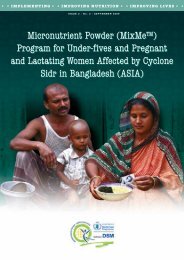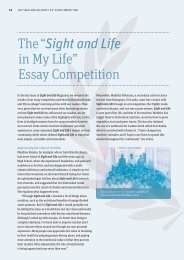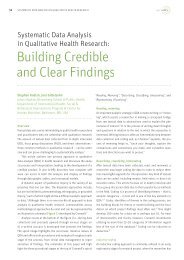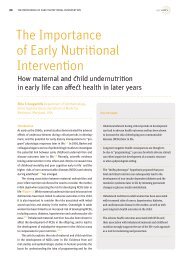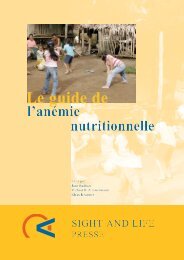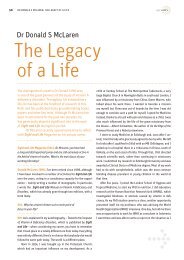Sight and Life Magazine 1/2011
Sight and Life Magazine 1/2011
Sight and Life Magazine 1/2011
You also want an ePaper? Increase the reach of your titles
YUMPU automatically turns print PDFs into web optimized ePapers that Google loves.
10 SIGHT AND LIFE STATEMENT<strong>Sight</strong> <strong>and</strong> <strong>Life</strong>StatementLow Dose Iron Multiple MicronutrientPowder: Rationale for Use in MalariaEndemic AreasMultiple micronutrient powders (MNPs) are packaged in singleor multi-dose sachets. These sachets contain micronutrientsin powdered form, <strong>and</strong> can be added to foods prepared in thehousehold just before consumption. Usually, one dose of MNPprovides the full unit of recommended nutrient intake (RNI) ofvitamins <strong>and</strong> minerals.In 2007, the use of MNPs, particularly in emergency conditions,was endorsed by the World Health Organization (WHO),the World Food Programme (WFP) <strong>and</strong> the United NationsChildren’s Fund (UNICEF) as an effective way of improving themicronutrient status of nutritionally vulnerable sections of thepopulation, such as children under five years of age <strong>and</strong> pregnant<strong>and</strong> lactating women. 1The risk of untargeted iron supplementationBased on results from a study conducted in Zanzibar 2 <strong>and</strong> otherbodies of evidence, 3,4 it was concluded that untargeted iron supplementationmay increase child morbidity <strong>and</strong> mortality frommalaria in the absence of monitoring <strong>and</strong> treatment programs.A sub-study analysis suggested that adverse events occurredin supplemented children who had not been iron-deficient. TheWHO Consultation on Prevention <strong>and</strong> Control of Iron Deficiencyin Infants <strong>and</strong> Young Children in Malaria Endemic Areas 5 concludedthat the safety of home fortification, as practiced at thattime, is uncertain, whereas food fortification programs are stillregarded as safe. In the above-mentioned study in Zanzibar, thenegative impact on iron-replete children was demonstrated atlevels of 12 mg Fe (as FeSO₄ supplement) per day. The bioavailabilityof FeSO₄ from a supplement is considerably higher thanbioavailability from fortified food, where the amount of availableiron depends on the food matrix. The children who showedadverse effects during iron supplementation had therefore beenexposed to high doses of absorbed <strong>and</strong> unabsorbed iron.As a result, the micronutrient powder mix for malaria endemicareas designed by DSM contains a significantly lower dose ofiron (2.5 mg, as NaFeEDTA) in combination with a known enhancerof iron absorption (ascorbic acid). This iron dose is closeto or even lower than amounts provided in food fortification programs,<strong>and</strong> is not comparable to the bolus doses administeredin iron supplementation programs. A consequence of the loweriron dose contained in the MNP sachets is the need to ensurethat the amount of (bioavailable) iron delivered is high enoughto the cover the needs of the individual.Currently the compound used is NaFeEDTA, which belongs toa group of iron compounds with a high relative bioavailabilitycompared to ferrous sulphate (FeSO₄). The main advantage ofNaFeEDTA is better bioavailability in the presence of iron absorptioninhibitors such as phytic acid <strong>and</strong> tannins, whereas thebioavailability of FeSO₄ is heavily dependent on the presence orabsence of such inhibitors. In particular, home-fortification islinked to the consumption of the local diet or local complementaryfoods, where starchy staples with a significant amount ofiron absorption inhibitors are consumed. In addition, accordingto the latest recommendations for flour fortification, 6 NaFeEDTAis the recommended compound for flours with high levels ofphytates (e.g. maize flour).Possible explanations for the Zanzibar resultsTwo possible explanations for the results seen in Zanzibar havebeen proposed: the formation of non-transferrin-bound iron(NTBI) in plasma, <strong>and</strong> the stimulation of pathogen growth in thegastrointestinal tract (due to the amount of unabsorbed iron).It has been proposed that administration of bolus doses of ironcan result in large amounts of unabsorbed iron, which enters<strong>and</strong> passes through the intestine. Recently published results 7indicate that unabsorbed iron from fortified foods modifies the



